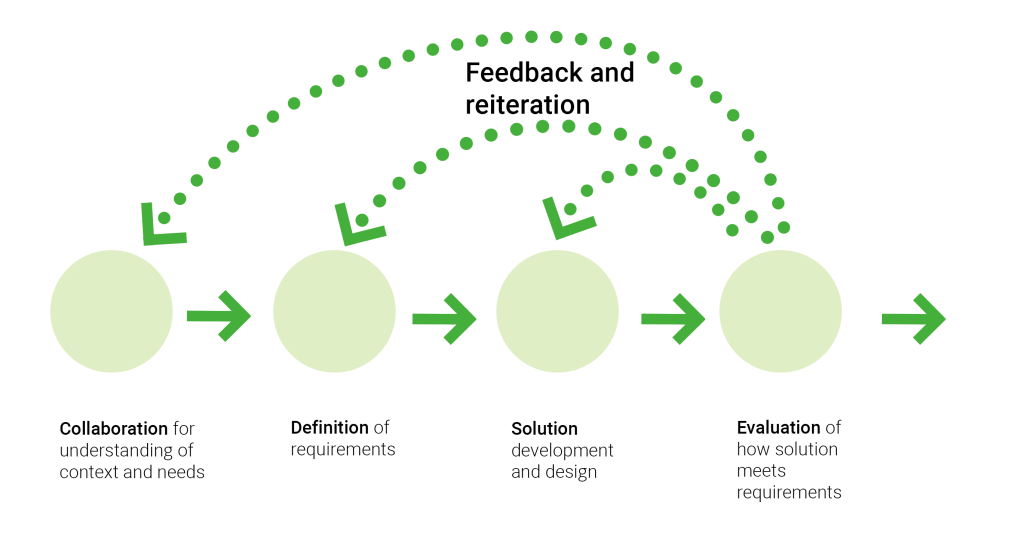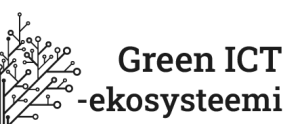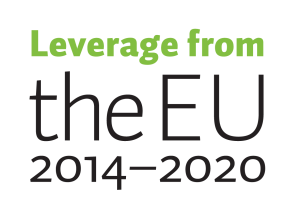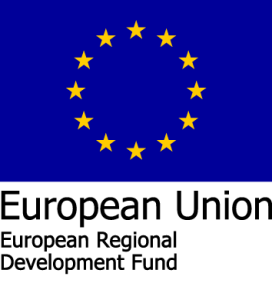
All ICT solutions are part of the problem, i.e., they all have a climate-negative footprint of some degree. However, they may also be part of the solution, i.e., achieve a climate-positive handprint. The #SMARTer2030 report by GeSI demonstrates clearly how the ICT sector has, in addition to its footprint, a considerable handprint, as employing ICT solutions aids other sectors in reducing their emissions.
The #SMARTer2030 report focuses on eight promising sectors (Energy, Agriculture, Health, Education, Manufacturing, Mobility & Logistics, Buildings, and Work&Business) that may utilise ICT and benefit from its usage, carbon footprint-wise. The European Green Deal mentioned elsewhere in this guide emphasises the same sectors.
The Carbon Handprint of ICT can be considered as the effects ICT solutions have on the field in which it is utilised. For example, navigation software assists in locating the shortest route from source to destination, and as such, the software reduces total emissions produced by the logistics operator. This effect is not realised in ICT but in the logistics sector when calculating emissions. In this case, the effect is positive, but this may not always be the outcome. For example, this same navigation software can instruct all drivers to choose a particular route, which may cause congestion, and thus causes delays, and may increase air pollution. Lastly, some effects may not happen immediately but can be delayed, manifesting only after a larger population has changed their behaviour. One example of this kind of systemic or structural change could be net banking, an ICT service that allows people to pay their bills online rather than visiting a bank. This ICT service has clearly reduced the number of physical banks in cities. In addition, the service has decreased its carbon footprint as a conventional paper invoice has a 30 to 50 times larger carbon footprint than an electronic invoice.
3.1. Understanding the Carbon Handprints of an ICT Product
Case Airbnb
Airbnb is a home renting service that provides authentic living experiences for travellers. Homeowners may rent their homes when they are uninhabited, and travellers have a larger selection of options available than just hotels. Both homeowners and travellers benefit financially. This was the original aim of the Airbnb developers.
However, for example, a recent study in New York (Wachsmuth 2018) has shown that Airbnb’s popularity has much greater impacts. Homeowners can indeed earn 55% more than the median long-term rent by using Airbnb, but that has caused 7 000-13 000 units of housing to be removed from the New York housing market, which has caused a 1.4% increase in long-term rents. So the increased income of homeowners and cheaper travel accommodation to tourists is indirectly also financed by ordinary New Yorkers living in these areas. As 72% of the population in these Airbnb locations are non-white, there’s a high risk of increased ethnic disparity.
The Airbnb example demonstrates that ICT solutions may have intended effects but result in unintended consequences. In many cases, the interconnectedness of different systems causes unforeseen cascading effects in other domains. These unintended consequences are hard to foresee.
The Sustainability Awareness Framework (SusAF) is a recent approach to increasing awareness and understanding of the potential sustainability impacts of a specific ICT product or solution. SusAF is a question-based framework that helps determine possible impacts on five dimensions of sustainability (Environmental, Economic, Social, Individual, and Technical) and three different temporal levels (Direct/Immediate, Indirect/Enabling, Systemic/Structural). In addition, SusAF offers a tool for considering chains of effects like the ones that materialised in our Airbnb example. SusAF is an open-source tool available in Zenodo for anyone interested. SusAF can be employed to achieve a better perspective of possible sustainability impacts. Results are often illustrated as SusADs (Sustainability Awareness Diagrams), as presented in Figure 6. In the SusAD, one may present the key positive (green) and negative (orange) impacts and their links to each other.

3.2. Examples of Handprints of Various Products
In this section, we’ll outline some examples of ICT solutions whose impacts are more positive than negative. We have selected three examples from different sectors. Uber focuses on mobility, one of the most significant sources of handprint impacts. Zoom (or Teams) has been a topical tool since Covid-19 and focuses on work, business, and learning activities. These virtual meeting platforms may significantly affect how we travel in our work and, as such, are linked with the mobility sector. RescueClub represents another sector, as this ICT solution decreases food waste by facilitating sales of surplus restaurant dishes.
Uber – a mobility service
Uber (and its counterparts like Lyft, Grab, etc.) provides a service for online ride-sourcing, like taxis. In one way, Uber reminds us of our AirBnB example, as Uber allows individuals to offer rides (as opposed to accommodation in AirBnB) to other people.
The Uber solution connects people with a need to people with the means. In most cases, the ride should be cheaper than using taxis, thus benefiting users while the drivers earn. If Uber’s availability is good enough, the service should reduce the need to own a car, reduce the need for parking spaces, etc.
However, a recent study by Henao (2017) calculated the impacts of Uber to travel efficiency in terms of time and distance, impacts on parking, behaviour changes, and implications on future travel modes. On the bright side, there is a reduced need for owning a car (reducing demand for parking) and, consequently, more flexibility in combining various transport means for a trip. On the downside, ridesharing extends the travelled distances compared to using a public transportation system (on average by 9 miles), and the drivers have unstable working conditions. Each 100 miles ride in Uber requires 69 miles of extra driving.
Thus once again, a seemingly efficient service introduces negative (rebound) effects that need to be considered while calculating the final outcome of the service.
Zoom – virtual meetings
The adoption of virtual meeting technologies, exemplified best by services such as Zoom (and Teams), represents a significant stride in promoting Green ICT. Virtual meeting products and services significantly reduce the need for physical transportations and hence reduces emissions associated with travelling to and from the meetings. Furthermore, these services enable a greater paperless environment and reduce the need for physical infrastructures. These services enhance hardware lifespans and lead to greater energy efficiencies – by virtue of being hosted on optimised cloud infrastructure.
A study by Faber (2020), looking into the AirMiners carbon removal networking community’s first virtual conference held on May 13, 2020, establishes that carbon emissions from just the air travel associated with this conference would have been 66 times that of the total carbon footprint of the Zoom enabled virtual conference. But then, Faber (2020) establishes in the same study that there is a measurable footprint of using Zoom with 64% of the emissions associated with the virtual conference coming directly from network data emissions. As more and more video gets streamed to more and more people, this footprint can become significant.
ResQ Club – Food waste elimination
ResQ Club is a company providing a digital service platform to connect sustainable restaurants, cafes, and grocery stores with consumers that value eating quality food at a reduced or affordable price. The platform is a location-based mobile and web service, allowing consumers to find and rescue nearby food surpluses. This helps to drastically reduce food waste and helps reduce hunger, inequality, improves good health and wellbeing, preserves the environment and increases the sustainability of cities and communities. Hence, the ResQ club digital service contributes directly towards achieving the UN sustainable development goals number 2, 3, 10, 11 and 13.
However, an unintended consequence of this intervention could be that, since companies know that their surplus will be rescued, it may lead to overproduction and overconsumption which acts contrary to SDG 12. Similarly, these surpluses are often taken away by customers, which increases the packaging waste. As a result, although food waste is reduced by rescuing the food surplus, packaging waste increases, which in most cases includes plastic and paper bags that are more expensive to recycle. According to the 2022 World Economic Forum, approximately 36% of all plastic produced is used to create packaging, of which 85% ends up in landfill.
3.3. Designing with a Carbon Handprint in Mind
As highlighted in earlier chapters, sustainability is a systemic issue that needs to be considered from the beginning of any development process. When designing digital services or products, frameworks like SusAF presented above can and should be utilised in the development process. Regardless of the method or framework used in the design process, the key steps of the software design process can be outlined, as shown in Figure 7. These steps can be recognized, e.g., in agile or DevOps frameworks as well as in the design thinking process.
The development process begins with understanding the context as well as the user or customer needs and defining the problem one wants to solve with the solution. Before the development itself, requirements need to be defined. During and after the development, evaluation needs to be done to ensure that the solution designed and developed meets the requirements that have been defined. When considering sustainability in the early stages, unwanted side effects can be detected before further development. Tools like SusAF help in increasing the understanding of the potential sustainability impacts the solution may have and thus help in refining the design, even in the early phases of the design process.

When designing with the handprint in mind, the importance of understanding the customer and end-user needs cannot be overemphasised. When you meet the user’s needs as well as possible, the service or product will use resources most efficiently during its lifecycle.
Find out more about the carbon handprint in the ICT sector
- Green ICT: Ilmasto- ja ympäristöystävällisyys lisäarvona B2B- ja kuluttajamarkkinoilla 24.11.2021. In Finnish.
- Green ICT: Ilmasto, kestävä kehitys ja vastuullisuus ICT-hankinnoissa 1.12.2021. In Finnish.
References
- Wachsmuth and A. Weisler. Airbnb and the rent gap: Gentrification through the sharing economy. Environment and Planning A: Economy and Space, 50(6):1147–1170, 2018.
- Henao A.: Impacts of Ridesourcing – Lyft and Uber – on Transportation including VMT, Mode Replacement, Parking, and Travel Behavior, Dissertation, University of Colorado, 2017. http://digital.auraria.edu/content/AA/00/00/60/55/00001/Henao_ucdenver_0765D_10823.pdf
- Kochanowska, W. R. Gagliardi, and with reference to Jonathan Ball, “The Double Diamond Model: In Pursuit of Simplicity and Flexibility,” in Perspectives on Design II, D. Raposo, J. Neves, and J. Silva, Eds., in Springer Series in Design and Innovation, vol. 16. Cham: Springer International Publishing, 2022, pp. 19–32. doi: 10.1007/978- 3-030-79879-6_2.
- https://www.nngroup.com/articles/design-thinking/
- Faber, G., 2021. A framework to estimate emissions from virtual conferences. International Journal of Environmental Studies, 78(4), pp.608-623.






